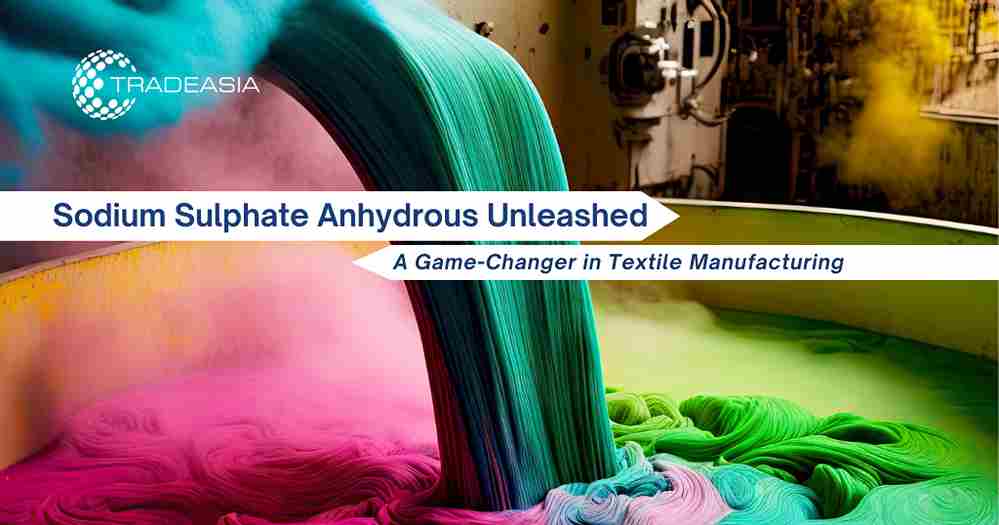
Introduction to Sodium Sulphate Anhydrous in Textile Manufacturing
In the intricate world of textiles, certain chemicals play a pivotal role in ensuring the quality and efficiency of production. One such chemical is sodium sulphate anhydrous, which finds extensive use in the textile industry. In this article, we will delve into the various aspects of sodium sulphate anhydrous in textiles, its significance, contribution, and the chemical processes that make it an essential component.
The Crucial Role of Sodium Sulphate Anhydrous in Textile
Sodium sulphate anhydrous holds a prominent position in the textile industry due to its multifaceted importance. It is highly valued for its role in facilitating various processes that lead to the creation of high-quality textiles. Its significance can be attributed to the following key aspects:
Dyeing and Printing
Sodium sulfate anhydrous is primarily used as a dyeing auxiliary in textile production. Its role is to aid in the even and uniform distribution of dyes onto fabric fibers during the dyeing and printing processes. By enhancing dye dispersion, it ensures that the colors are vivid and consistent, resulting in high-quality dyed and printed textiles.
Dye Fixation
Sodium sulfate anhydrous also plays a vital role in dye fixation, a process that ensures the dyes bond firmly with the textile fibers. This is crucial for achieving colorfastness, where the colors resist fading or bleeding when exposed to various conditions, such as washing, sunlight, or wear and tear.
Reduction of Dyeing Temperature
In some dyeing processes, sodium sulfate anhydrous is used to lower the temperature at which the dyeing occurs. This not only saves energy but also reduces the risk of damaging sensitive or delicate fabrics that may be sensitive to high temperatures.
Prevention of Precipitation
Sodium sulfate anhydrous helps prevent the precipitation of certain dyes and impurities in the dye bath. When these substances precipitate, they can negatively impact the dyeing process and result in uneven coloration or staining on the fabric.
Improved Washing and Rinsing
In addition to dyeing, sodium sulfate anhydrous can improve the washing and rinsing processes in textile production. It aids in the removal of residual dyes and chemicals from the fabric, ensuring that the final product is clean, soft, and free from unwanted contaminants.
Desizing
In textile manufacturing, fabrics often undergo a sizing process to strengthen them. Sodium sulphate anhydrous aids in the efficient removal of sizing agents from the fabric, allowing for better absorption of dyes and chemicals.
Preventing Fiber Damage
It helps prevent fiber damage during the dyeing process, thereby preserving the integrity of the textile material.
Buffering Agent
Sodium sulphate anhydrous acts as a buffering agent, ensuring that the pH levels in dye baths remain stable. This is crucial for achieving the desired color results.
Cost Efficiency
Sodium sulfate anhydrous is a cost-effective additive in textile dyeing and printing. Its ability to enhance dye dispersion and fixation allows textile manufacturers to use less dye and chemicals, reducing production costs.
Chemical Process of Sodium Sulphate in Textile
The chemical process involving sodium sulphate anhydrous in textiles is a crucial aspect to understand its contribution fully. Sodium sulphate anhydrous interacts with water and other chemicals in textile processes, leading to the following reactions:
- Dye Dissolution
The first step in the chemical process involves dissolving anhydrous sodium sulfate in water. This results in the formation of a sodium sulfate solution. The concentration of the solution may vary depending on the specific application within textile manufacturing. Sodium sulphate anhydrous aids in the dissolution of dyes, making them more soluble and easily absorbed by textile fibers. This results in vibrant and long-lasting colors. - Sizing Removal
In desizing, it breaks down the sizing agents applied to fabrics during the weaving process. This breakdown allows for the sizing to be washed away effectively, leaving behind clean, ready-to-dye textiles. - pH Stabilization
Sodium sulphate anhydrous helps stabilize the pH levels in dye baths, preventing sudden fluctuations that can adversely affect dyeing outcomes.
Conclusion
In the intricate realm of textile manufacturing, sodium sulphate anhydrous emerges as a game-changer. Its multifaceted importance encompasses vibrant dyeing, efficient printing, colorfastness, cost savings, and textile preservation. Moreover, its chemical processes facilitate dye dissolution, sizing removal, and pH stabilization. Sodium sulphate anhydrous is more than just a chemical; it’s a crucial ally in creating high-quality textiles that stand the test of time and fashion trends.




